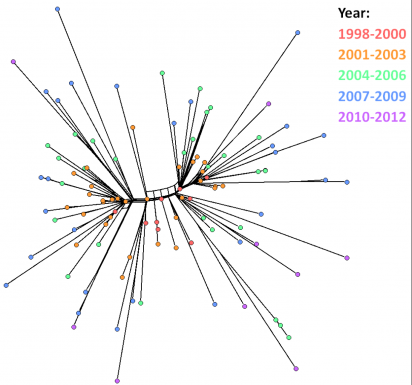IDReC Sam Bloomfield , Research into cause of human salmonellosis cases in New Zealand.
by Simon Verschaffelt

In New Zealand, most salmonellosis cases are caused by Salmonella enterica serovar Typhimurium. In 1998, Salmonella Typhimurium DT160 was isolated from a human salmonellosis patient in New Zealand. S. Typhimurium DT160 then became the predominant strain isolated from human salmonellosis cases until 2010. During this time, S. Typhimurium DT160 infected and killed multiple wild birds throughout New Zealand, and was isolated from a large number of other animals (e.g. cows and chickens). Samuel has been using whole genome sequencing to determine how S. Typhimurium evolved over the course of the outbreak, how it was transmitted between the various affected populations, and how it was superseded by other Salmonella strains as the predominant cause of human salmonellosis cases in New Zealand. Current work indicates that S. Typhimurium DT160 radiated out from a point source over time, and that there was a large amount of transmission between the various affected populations.

Figure 1. NeighbourNet tree of 109 Salmonella Typhimurium DT160 isolates (based on 793 core SNPs) and coloured by year. The red dots represent DT160 isolates collected from 1999 – 2000, the orange dots represent DT160 isolates isolated from 2001 – 2003, the green dots represent DT160 isolates collected from 2004 – 2006, the blue dots represent DT160 isolates collected from 2007 – 2009, and the purple dots represent DT160 isolated collected from 2010 – 2012.